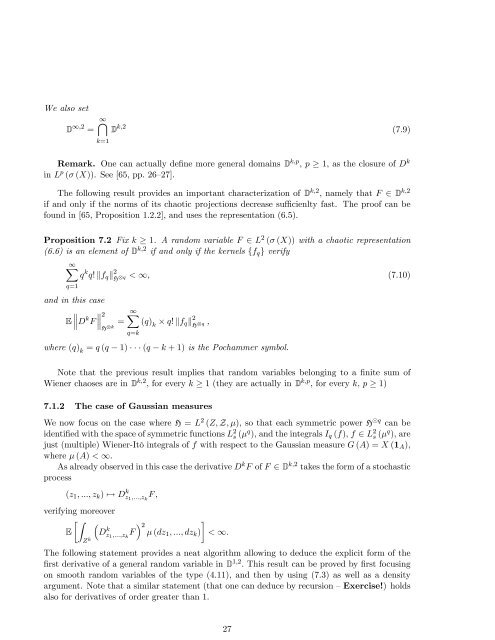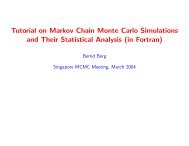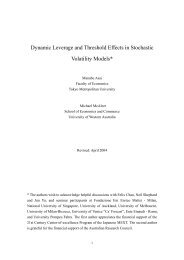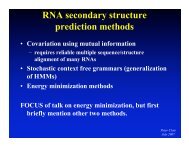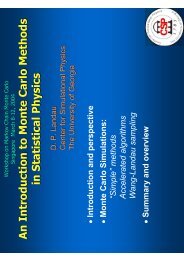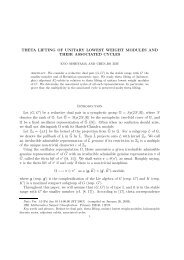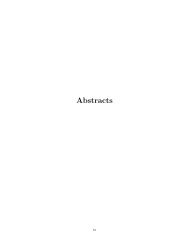Stein's method, Malliavin calculus and infinite-dimensional Gaussian
Stein's method, Malliavin calculus and infinite-dimensional Gaussian
Stein's method, Malliavin calculus and infinite-dimensional Gaussian
You also want an ePaper? Increase the reach of your titles
YUMPU automatically turns print PDFs into web optimized ePapers that Google loves.
We also set<br />
D 1;2 =<br />
1\<br />
D k;2 (7.9)<br />
k=1<br />
Remark. One can actually de…ne more general domains D k;p , p 1, as the closure of D k<br />
in L p ( (X)). See [65, pp. 26–27].<br />
The following result provides an important characterization of D k;2 , namely that F 2 D k;2<br />
if <strong>and</strong> only if the norms of its chaotic projections decrease su¢ cienlty fast. The proof can be<br />
found in [65, Proposition 1.2.2], <strong>and</strong> uses the representation (6.5).<br />
Proposition 7.2 Fix k 1. A r<strong>and</strong>om variable F 2 L 2 ( (X)) with a chaotic representation<br />
(6.6) is an element of D k;2 if <strong>and</strong> only if the kernels ff q g verify<br />
1X<br />
q k q! kf q k 2 H<br />
< 1, (7.10)<br />
q<br />
q=1<br />
<strong>and</strong> in this case<br />
<br />
E D k F 2 = X<br />
1 (q) k<br />
q! kf q k 2<br />
H k H<br />
, q<br />
q=k<br />
where (q) k<br />
= q (q 1) (q k + 1) is the Pochammer symbol.<br />
Note that the previous result implies that r<strong>and</strong>om variables belonging to a …nite sum of<br />
Wiener chaoses are in D k;2 , for every k 1 (they are actually in D k;p , for every k; p 1)<br />
7.1.2 The case of <strong>Gaussian</strong> measures<br />
We now focus on the case where H = L 2 (Z; Z; ), so that each symmetric power H q can be<br />
identi…ed with the space of symmetric functions L 2 s ( q ), <strong>and</strong> the integrals I q (f), f 2 L 2 s ( q ), are<br />
just (multiple) Wiener-Itô integrals of f with respect to the <strong>Gaussian</strong> measure G (A) = X (1 A ),<br />
where (A) < 1:<br />
As already observed in this case the derivative D k F of F 2 D k;2 takes the form of a stochastic<br />
process<br />
(z 1 ; :::; z k ) 7! D k z 1 ;:::;z k<br />
F ,<br />
verifying moreover<br />
<br />
2<br />
E Dz ZZ k 1 ;:::;z k<br />
F (dz1 ; :::; dz k ) < 1:<br />
k<br />
The following statement provides a neat algorithm allowing to deduce the explicit form of the<br />
…rst derivative of a general r<strong>and</strong>om variable in D 1;2 : This result can be proved by …rst focusing<br />
on smooth r<strong>and</strong>om variables of the type (4.11), <strong>and</strong> then by using (7.3) as well as a density<br />
argument. Note that a similar statement (that one can deduce by recursion –Exercise!) holds<br />
also for derivatives of order greater than 1.<br />
27


